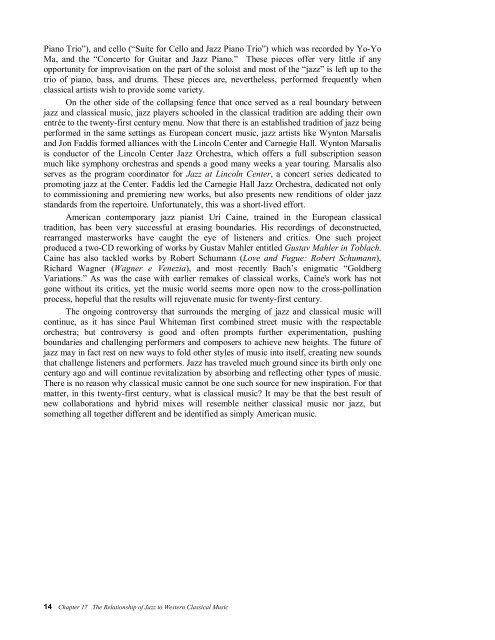THE RELATIONSHIP OF JAZZ TO WESTERN CLASSICAL MUSIC
THE RELATIONSHIP OF JAZZ TO WESTERN CLASSICAL MUSIC
THE RELATIONSHIP OF JAZZ TO WESTERN CLASSICAL MUSIC
Create successful ePaper yourself
Turn your PDF publications into a flip-book with our unique Google optimized e-Paper software.
Piano Trio”), and cello (“Suite for Cello and Jazz Piano Trio”) which was recorded by YoYo<br />
Ma, and the “Concerto for Guitar and Jazz Piano.” These pieces offer very little if any<br />
opportunity for improvisation on the part of the soloist and most of the “jazz” is left up to the<br />
trio of piano, bass, and drums. These pieces are, nevertheless, performed frequently when<br />
classical artists wish to provide some variety.<br />
On the other side of the collapsing fence that once served as a real boundary between<br />
jazz and classical music, jazz players schooled in the classical tradition are adding their own<br />
entrée to the twentyfirst century menu. Now that there is an established tradition of jazz being<br />
performed in the same settings as European concert music, jazz artists like Wynton Marsalis<br />
and Jon Faddis formed alliances with the Lincoln Center and Carnegie Hall. Wynton Marsalis<br />
is conductor of the Lincoln Center Jazz Orchestra, which offers a full subscription season<br />
much like symphony orchestras and spends a good many weeks a year touring. Marsalis also<br />
serves as the program coordinator for Jazz at Lincoln Center, a concert series dedicated to<br />
promoting jazz at the Center. Faddis led the Carnegie Hall Jazz Orchestra, dedicated not only<br />
to commissioning and premiering new works, but also presents new renditions of older jazz<br />
standards from the repertoire. Unfortunately, this was a shortlived effort.<br />
American contemporary jazz pianist Uri Caine, trained in the European classical<br />
tradition, has been very successful at erasing boundaries. His recordings of deconstructed,<br />
rearranged masterworks have caught the eye of listeners and critics. One such project<br />
produced a twoCD reworking of works by Gustav Mahler entitled Gustav Mahler in Toblach.<br />
Caine has also tackled works by Robert Schumann (Love and Fugue: Robert Schumann),<br />
Richard Wagner (Wagner e Venezia), and most recently Bach’s enigmatic “Goldberg<br />
Variations.” As was the case with earlier remakes of classical works, Caine's work has not<br />
gone without its critics, yet the music world seems more open now to the crosspollination<br />
process, hopeful that the results will rejuvenate music for twentyfirst century.<br />
The ongoing controversy that surrounds the merging of jazz and classical music will<br />
continue, as it has since Paul Whiteman first combined street music with the respectable<br />
orchestra; but controversy is good and often prompts further experimentation, pushing<br />
boundaries and challenging performers and composers to achieve new heights. The future of<br />
jazz may in fact rest on new ways to fold other styles of music into itself, creating new sounds<br />
that challenge listeners and performers. Jazz has traveled much ground since its birth only one<br />
century ago and will continue revitalization by absorbing and reflecting other types of music.<br />
There is no reason why classical music cannot be one such source for new inspiration. For that<br />
matter, in this twentyfirst century, what is classical music? It may be that the best result of<br />
new collaborations and hybrid mixes will resemble neither classical music nor jazz, but<br />
something all together different and be identified as simply American music.<br />
14 Chapter 17 The Relationship of Jazz to Western Classical Music

















